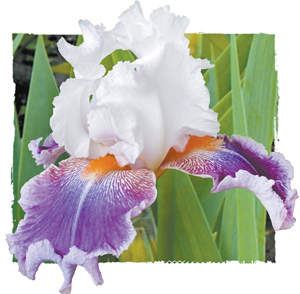Irises for Lina Kostenko
A Ternopil-based florist created a new strain of iris for the poetess’ birthday and called it “Hyacinth Sun”
Over twenty years of breeding Ihor Khorosh has collected more than 70 types of iris. But he and Lina Kostenko’s fans admire the strains made for the poetess most of all. Last summer Ihor Khorosh presented a new strain of iris called “Lina Kostenko” at an exhibit in Ternopil. Later the series was completed by the iris called “The Snow in Florence.” He recently bred one more variety, the “Hyacinth Sun,” dedicated to one of the last books by Lina Kostenko, presented after her many-year hiatus. Before the poetess’ birthday on Saturday, March 19, The Day interviewed the breeder.
“I’ll try to wish her a happy birthday by phone, but if I don’t manage to do it, I’d like to wish her a lot of health to realize everything she planned so that her works would plant the seeds of good and they would germinate. I know that she will be busy on this day. I remember her poem about the talkative guest very well so I treasure her time and try not to hinder her work. Lina Kostenko has versatile interests and when we have a chance to talk we discuss different issues. I’ve known her for about a year. In fact, the variety of iris I dedicated to her jubilee made us meet. I combined several varieties of iris, one flower was beige, and the other one was dark violet. As a result I got the flower with the white top and the golden-yellow bottom. Breeding is very interesting as you never know what you will get.”
Why is your creative work so close to Lina Kostenko?
“I’ve been reading Lina Kostenko since my childhood. Some people have a taste for Ivan Franko, Lesia Ukrainka, Taras Shevchenko... but I like Lina Kostenko. Probably, the reason for this is that we were born on the same day. Her poetry is extremely true, it has an educational component and all of it is perfect. I wanted to read those poems, though they were banned.”
Everything that is banned attracts…
“Even more. Lina Kostenko’s poetry is self-explanatory, it doesn’t need any epithets.”
Why did you dedicate the flowers to the poetess now, did you wait for the specific moment?
“By intuition I really waited for her to appear among the people and it coincided with the presentation of the first variety of flowers, dedicated personally to her. Lina Kostenko is an important personality. I think that flowers have to be pure, just like the people they are dedicated to. Flowers are called by different names. I have 75 varieties, registered in the International Iris Society. Every year I breed seven new varieties and give them different names, but there are only several personal ones: “Nazarii Yaremchuk” and “Myroslava,” dedicated to my mother; the personal variety called “Halyna Kornienko,” dedicated to the floristics teacher. There’s also “Barbara Brylska,” I know her as well. One variety is dedicated to Hanna Herman, whose songs educated me. Last year I was very pleased when Lina Kostenko became accessible for the people. It confirmed the talent, humanness and good that she brings.”
Except for the personal variety of iris, dedicated to the poetess, you also have “The Snow in Florence”...
“Lina Kostenko wrote The Snow in Florence, impressed by the events in Florence in honor of Giovanni Francesco Rustici, whose creative work is related to Leonardo da Vinci. I read The Snow in Florence twice, the same as The Diary of a Ukrainian Madman, I think that in a month or two, I will get back to this book, as these books are very strong. Actually, I bred this variety because I was impressed by them. At first glance, it’s similar to the new “Hyacinth Sun,” but the first one has the snow-white top and the dark-violet bottom and the second one has the lilac top and the dark-violet bottom. Breeding a new variety of flowers takes seven to eight years. This time is needed from the moment when I collect the seeds and fertilize them till the moment when I register the new variety.”
The fact that your flowers are dedicated to such a personality as Lina Kostenko makes them more valuable. How do your colleagues and those who take interest in the new flowers react?
“I don’t seek demand for my flowers, I don’t need vain popularity. I just want to please this person and to give my flowers decent names, so that people know who the flowers are dedicated to. With my flowers I want to make people kinder, to distract them from their everyday problems and to remind them that there’s something beautiful in the world.”






